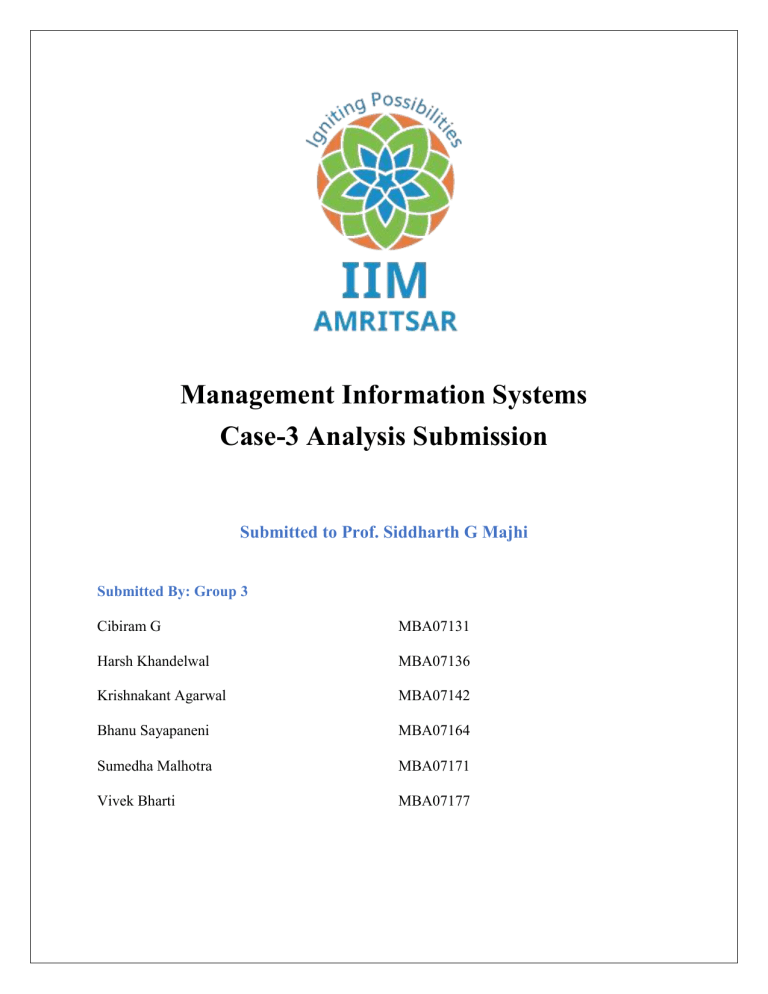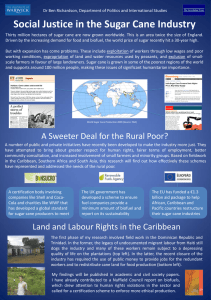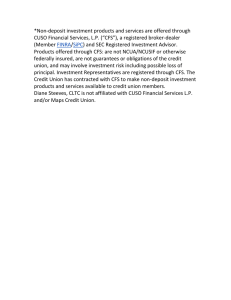Cheeni Case Study: MIS Analysis & IT in Sugar Industry
advertisement

Management Information Systems Case-3 Analysis Submission Submitted to Prof. Siddharth G Majhi Submitted By: Group 3 Cibiram G MBA07131 Harsh Khandelwal MBA07136 Krishnakant Agarwal MBA07142 Bhanu Sayapaneni MBA07164 Sumedha Malhotra MBA07171 Vivek Bharti MBA07177 Q1. What is the industry in which ‘Cheeni’ is operating? Enumerate the key issues faced by this industry. Ans: Cheeni is operating in Sugar Industry. Some of the challenges faced by this industry are as follows1. Uncertain Production Output-The production of sugar varies from year to year which in turn causes fluctuations in prices which leads to losses when there is excess production due to low prices. 2. Low Yield of Sugarcane- The yield per hectare in India is extremely low in comparison to major sugarcane producing. 3. Short crushing season- The production of sugar is a seasonal industry which varies from 4 to 7 months in a year. This leads to seasonal employment for workers and lack of complete utilization of sugar mills. 4. Low sugar recovery rate- The average rate of recovery of sugar from sugarcane is comparatively lower than other sugar producing countries. 5. Government policy and control-The sugar prices are being controlled through several government policies- export duty, stock limit on sugar mills, etc. These controls have resulted in little or no profit for these sugar mills and increased the dues to be paid to the sugarcane farmers. Q2. Discuss how ‘Cheeni’ works with farmers in terms of supplying plants, monitoring, financial support, and other initiatives. What is the role of cane field staff (CFS)? For Cheeni, yield and Quality of sugarcane are important parameters; therefore, they keep in proximity with farmers. 1. To maintain a close relationship with farmers, they provide plants from their nursery to the farmers during sowing. Also, advise them on nutrition requirements for soil and crop, pesticides required for sugarcane crop, etc. 2. Sugarcane typically takes 10-14 months period from sowing to ripening. Cheeni also monitors crops during the period through its mechanism called-“doc format,” where the company representative visits the field every three months (approx. 4 times in total)and evaluates the growth of the crop, sugarcane quality, presence of disease, etc. Post that, they prepare a document and give advisory to farmers. 3. Financial support to farmers is provided based on the progress of the crop. Instead of providing one-time payment to farmers, they provide part payment to keep sufficient working capital with themselves and keep liquidity in the hand of farmers to meet the need of crops and their own families. 4. Some new initiatives are also started by Cheeni like weather updates, yield improvement activities, providing mechanical harvesters on-demand and scheduling of cutting for various farmers, etc. CFS provided with monitoring and recording the various aspects related to cane growth, input provision, disease control, financial support, etc. CFS were also involved in coordinating the procurement of sugarcane from the growers. CFS had knowledge of rural India and also developed close relationships with farmers and their community. They also were one-stop shop for information relating to various needs of the farmers themselves. CFS also kept a close track of cane growth in the various farms under their supervision. CFS were also provided with PDAs that made transfer and retrieval of information more efficient and time consuming. Apart from this CFS monitored and recorded cane growth information and field updates. They also had information from the Web CMS against the farmer's identity. Information such as availability of cane sets at nursery for planting, availability of fertilizers and pesticides stock, past payments made to the farmer by Cheeni, loan outstanding against the farmer, cane crushed and recovery details at the factory site, etc. are also available to the CFS to be provided to the farmer on request. Hence, CFS acted as a support system for the farmer community and increased the overall efficiency of process. Q3. Why did ‘Cheeni’ experience the need for an innovative IT application? Where did the idea for IT intervention emerges? Can an organization rely on this mode of planning for sustaining IT innovations? So, first, let's take a look at their existing procedure. The Cane Field Staff (CFS) is required to check the development of the cane growth every three months. When the field visits the farm, a "doc" is generated. They usually came every three, six, nine, or twelve months. These documents are used to provide advice to farmers. The difficulty with manual recording is that the CFS encompassed a wide range of geographies and farms. This made the work more difficult and resulted in time wasted while looking for information. As the CFS is responsible for monitoring and recording many areas of data such as input provision, illness control, financial assistance, and so on. Cheeni saw a need for an unique IT solution to maintain track of the vast volume of data gathered in the field from over a hundred thousand farmers spread across hundreds of communities. As a result, the farms and factories must be linked, and the factory must be informed of harvest periods in order to minimise scheduling conflicts among numerous cane growers. As a result, several manufacturers have already begun to rely on information technology to construct cane supply calendars, issue supply tickets to farmers, pay farmers via bank linkages, and maintain cane grower data. As a result, cooperative society factories in certain states have already begun to make extensive use of information technology to assist in the preparation of cane supply calendars, the issuance of supply tickets to farmers, payment to farmers via bank linkages, and the preservation of farmers' records. Q4. What are the IT related components introduced in ‘Cheeni’? Explain the role of these. IT innovations in addressing the issues faced by farmers and other stakeholders. Ans: Personal Digital Assistants (PDAs): devices that are pre-loaded with an appropriate IT application for capturing the required data. In partnership with the CFS, the firm's IT department built and developed a platform that gave them the requisite mobility and precision in data collecting. This programme provided access to a web-based cane management system (CMS). The application allowed the CFS to retrieve information from the Web CMS against the farmer's identity, as well as monitor and record cane growth information and field updates. The CFS has access to information such as the availability of cane sets at the nursery for planting, fertiliser and pesticide stock, previous Cheeni payments to the farmer, loans owed to the farmer, cane crushed and recovery details at the factory site, and so on. The CFS's rapid adoption of PDAs and use of the tool resulted in a significant reduction in the amount of time it took to provide information to farmers. Furthermore, because of the mobility enabled by PDAs, the CFS was able to deliver the information required by the farmer on the farm rather than requiring the farmer to attend the section office.

